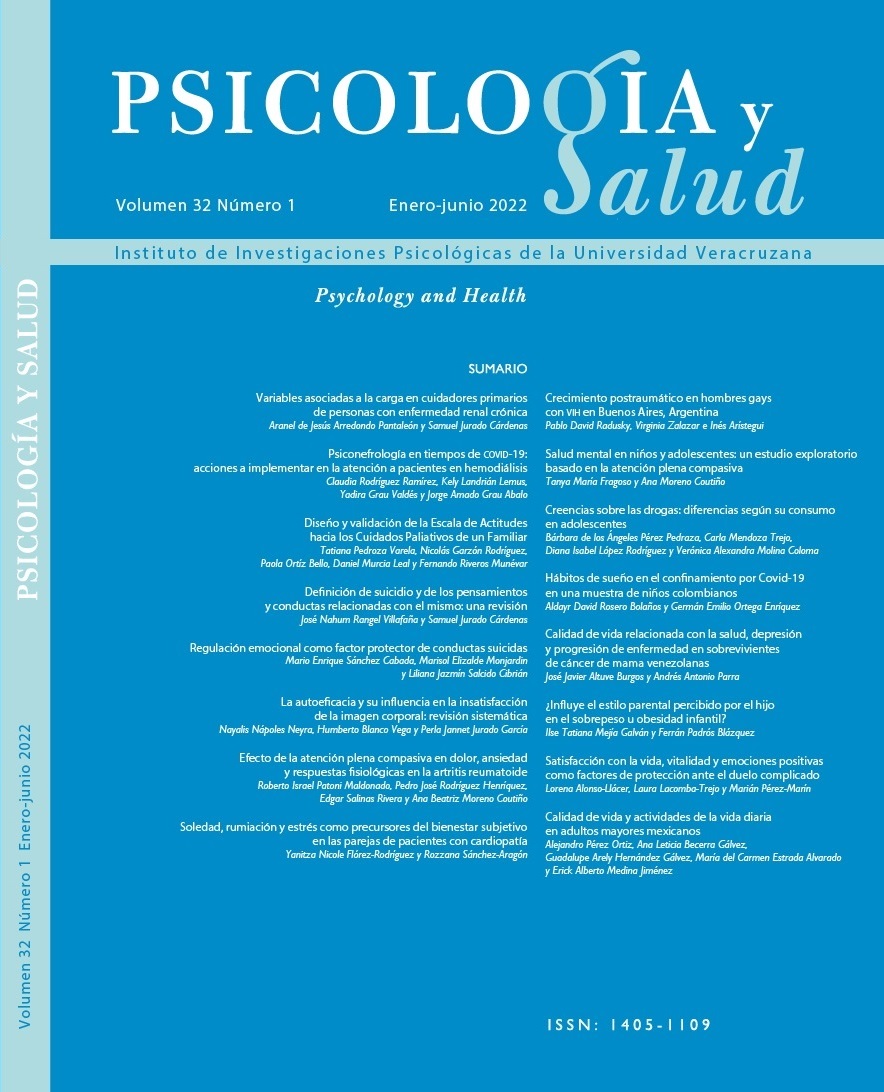Abstract
Every year more than 800,000 suicides occur globally, roughly one every 40 seconds. In Mexico, 6,559 suicides were reported in 2017, which showed an increase in the suicide rate, implying a high social-impact phenomenon. Researchers and professionals need to address thoughts and behaviors related to suicide with evidence-based strategies to prevent these trends. Reliable conceptual and operational definitions perform a crucial role toward this purpose as they directly relate to the internal validity of studies in the area. Thus, the objective of this paper was to partially analyze the international research literature on the definition of suicide and various proposals to define the thoughts and behaviors related to this phenomenon. Results point to the three most used related thoughts, which lead to suggestions for health professionals in Mexico.
References
Barczyk, A.N., Piper, K., Duzinski, S.V., Klingensmith, M. y Lawson, K.A. (2018). Youth suicide attempt nomenclature used in two central Texas hospitals. Crisis, 39. 461-468.
Borges, G., Orozco, R., Benjet, C. y Medina-Mora, M.E. (2012). Suicidio y conductas suicidas en México: retrospectiva y situación actual. Salud Publica de México, 52(4), 292-304.
Brenner, L.A., Breshears, R.E., Betthauser, L.M., Bellon, K.K., Holman, E., Harwood, J.E., Silverman, M.M., Huggins, J. y Nagamoto, H.T. (2011). Implementation of a suicide nomenclature within two VA healthcare settings. Journal of Clinical Psychology in Medical Settings, 18, 116-128.
Crosby, A.E., Ortega, L. y Melanson, C. (2011). Self-directed violence surveillance: Uniform definitions and recommended data elements (Version 1.0). Atlanta (GA): Centers for Disease Control and Prevention, and National Center for Injury Prevention and Control.
De Leo, D., Burgis, S., Bertolote, J., Kerkhof, A.D.M. y Bille-Brahe, U. (2004). Definitions of suicidal behavior. En D. de Leo, U. Bille-Brahe, A. D M. Kerkhof y A. Schmidtke (Eds.): Suicidal behavior: Theories and research findings (pp. 17-39). Washington, D.C: Hogrefe & Huber.
Durkheim, E. (1897). Le suicide. Étude de sociologie. Paris: Félix Alcan.
Glasziou, P., Del Mar, C. y Salisbury, J. (2003). Evidence-based medicine workbook. Finding and applying the best evidence to improve patient care. London: BMJ Books.
H. Congreso de la Unión (2018). Ley general de acceso de las mujeres a una vida libre de violencia. Diario Oficial de la Federación (13 de abril). Ciudad de México.
Instituto Nacional de Estadística e Informática (2019, 12 de febrero). Datos. Mortalidad. Tabulados. Mortalidad general. Ciudad de México: INEGI. Recuperado de https://www.inegi.org.mx/app/tabulados/pxweb/inicio.html?rxid=91a63b16-b544-4b50-8b37-90d5868e9620ydb=Saludypx=Mental_06.
Kattimani, S., Bharadwaj, B., Sarkar, S. y Mukherjee, A. (2015). Interrater reliability of the Silverman et al. nomenclature for suicide-related ideations, behaviors, and communications. Crisis, 36(1), 61-64.
Kerlinger, F.N. y Lee, H.B. (2002). Investigación del comportamiento: Métodos de investigación en ciencias sociales. México: McGraw-Hill.
Krug, E.G., Dahlberg, L.L., Mercy, J.A., Zwi, A.B. y Lozano, R. (2002). World report on violence and health. Geneva: World Health Organization.
Matarazzo, B.B., Clemans, T.A., Silverman, M.M. y Brenner, L.A. (2013). The Self-Directed Violence Classification System and the Columbia Classification Algorithm for suicide assessment: A crosswalk. Suicide and Life-Threatening Behavior, 43(3), 235-249.
O’Carroll, P.W., Berman, A.L., Maris, R.W., Moscicki, E.K., Tanney, B.L. y Silverman, M.M. (1996). Beyond the tower of Babel: A nomenclature for suicidology. Suicide and Life-Threatening Behavior, 26(3), 237-252.
O’Connor, R.C. y Nock, M.K. (2014). The psychology of suicidal behavior. Lancet Psychiatry, 1, 73-85.
Organización Mundial de la Salud (OMS) (1990). Clasificación Estadística Internacional de Enfermedades y Problemas Relacionados con la Salud (10ª revisión: CIE-10). Ginebra: OMS.
Organización Mundial de la Salud (2018b). CIE-11 para estadísticas de mortalidad y morbilidad. Ginebra: OMS. Recuperado de: https://icd.who.int/browse11/l-m/es psychosocial disorders. Suicide. Ginebra: OMS.
Posner, K., Brodsky, B., Yershova, K., Buchanan, J. y Mann, J. (2014). The classification of suicidal behavior. En M.K. Nock (Ed.): The Oxford handbook of suicide and self-injury (pp. 7-22). New York: Oxford University Press.
Rubin, A. y Bellamy, J. (2012). Practitioner’s guide to using research for evidence-based practice. New York: Wiley & Sons.
Ruiz J., C. y Blanco, P. (2004). La violencia contra las mujeres: prevención y detección. Cómo promover desde los servicios sanitarios relaciones autónomas, solidarias y gozosas. Madrid: Díaz de Santos.
Shneidman, E.S. (1985). Definition of suicide. New York: John Wiley & Sons.
Silverman, M.M. (2006). The language of suicidology. Suicide and Life-Threatening Behavior, 36(5), 519-532.
Silverman, M.M., Berman, A.L., Sanddal, N.D., O’Carroll, P.W. y Joiner, T.E. (2007a). Rebuilding the tower of Babel: A revised nomenclature for the study of suicide and suicidal behaviors, Part 1: Background, rationale, and methodology. Suicide and Life-Threatening Behavior, 37(3), 248-263.
Silverman, M.M., Berman, B.L., Sanddal, N.D., O’Carroll, P.W. y Joiner, T.E. (2007b). Rebuilding the tower of Babel: A revised nomenclature for the study of suicide and suicidal behaviors, Part 2: Suicide-related ideations, communications, and behaviors. Suicide and Life-Threatening Behavior, 37(3), 264-277.
Silverman, M.M. y De Leo, D. (2016). Why there is a need for an international nomenclature and classification system for suicide. Crisis, 37(2), 83-87.
Skinner, B.F. (1957). Verbal behavior. New York: Appleton-Century-Crofts.
World Health Organization (2012). Public health action for the prevention of suicide. A framework. Geneva: WHO.
World Health Organization (2018a). Global health observatory data repository. Suicide rates, age-standardized. Data by country. Recuperado de http://apps.who.int/gho/data/node.main.MHSUICIDEASDR?lang=en.
World Health Organization and Panamerican Health Organization (1998). Primary prevention of mental, neurological and psycho-social disorders. Washington: WHO-PHO.

